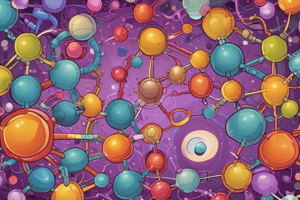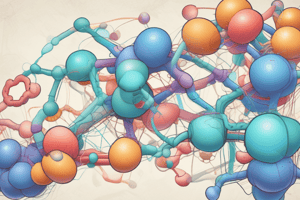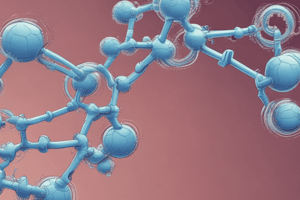Podcast
Questions and Answers
What type of fatty acids are solid at body temperature due to being composed of saturated fatty acids?
What type of fatty acids are solid at body temperature due to being composed of saturated fatty acids?
- Triglycerides (correct)
- Unsaturated fatty acids
- Trans fatty acids
- Phospholipids
How do the double bonds in natural unsaturated fatty acids primarily orient?
How do the double bonds in natural unsaturated fatty acids primarily orient?
- In a spiral shape
- In a linear shape
- In a bent shape (correct)
- In a zig-zag shape
Which fatty acids are associated with an increased risk of diseases such as cardiovascular disease and diabetes?
Which fatty acids are associated with an increased risk of diseases such as cardiovascular disease and diabetes?
- Long-chain fatty acids
- Saturated fatty acids
- Trans fatty acids (correct)
- Cis fatty acids
Why can't the brain efficiently use fatty acids as a source of fuel?
Why can't the brain efficiently use fatty acids as a source of fuel?
Which of the following is a disadvantage of using fatty acids as an energy source in neurons?
Which of the following is a disadvantage of using fatty acids as an energy source in neurons?
What biological function do fatty acids serve aside from being a source of energy?
What biological function do fatty acids serve aside from being a source of energy?
What is the primary reason that fatty acids cannot ensure rapid ATP generation during high neuronal activity?
What is the primary reason that fatty acids cannot ensure rapid ATP generation during high neuronal activity?
In the context of fatty acids, what does biohydrogenation primarily refer to?
In the context of fatty acids, what does biohydrogenation primarily refer to?
What triggers the secretion of secretin in the small intestine?
What triggers the secretion of secretin in the small intestine?
Which component is primarily secreted by the pancreas in response to secretin?
Which component is primarily secreted by the pancreas in response to secretin?
What is the main process by which triacylglycerols are packaged in intestinal cells?
What is the main process by which triacylglycerols are packaged in intestinal cells?
Which lipoprotein primarily transports dietary lipids from the intestine?
Which lipoprotein primarily transports dietary lipids from the intestine?
Which statement is true regarding apolipoproteins?
Which statement is true regarding apolipoproteins?
Which of the following is NOT one of the five major plasma lipoproteins?
Which of the following is NOT one of the five major plasma lipoproteins?
What happens to fatty acids and monoacylglycerols after digestion?
What happens to fatty acids and monoacylglycerols after digestion?
Which of the following is true about integral and peripheral apolipoproteins?
Which of the following is true about integral and peripheral apolipoproteins?
Which enzyme is responsible for converting palmitoyl-CoA to palmitoleoyl-CoA during the synthesis of monounsaturated fatty acids?
Which enzyme is responsible for converting palmitoyl-CoA to palmitoleoyl-CoA during the synthesis of monounsaturated fatty acids?
What is the role of methylene groups in the synthesis of polyunsaturated fatty acids?
What is the role of methylene groups in the synthesis of polyunsaturated fatty acids?
What happens to desaturation and elongation systems during a starving state?
What happens to desaturation and elongation systems during a starving state?
What is the primary reason that triacylglycerols cannot penetrate cell membranes?
What is the primary reason that triacylglycerols cannot penetrate cell membranes?
Where does the synthesis of triacylglycerol primarily occur in the body?
Where does the synthesis of triacylglycerol primarily occur in the body?
Which pathway is involved in the conversion of glycerol-3-phosphate to phosphatidate?
Which pathway is involved in the conversion of glycerol-3-phosphate to phosphatidate?
Which condition is known to diminish the desaturation and elongation enzyme systems?
Which condition is known to diminish the desaturation and elongation enzyme systems?
What is the initial step in synthesizing triacylglycerols in tissues?
What is the initial step in synthesizing triacylglycerols in tissues?
What is the primary function of chylomicrons?
What is the primary function of chylomicrons?
Which lipoprotein primarily delivers cholesterol to various tissues?
Which lipoprotein primarily delivers cholesterol to various tissues?
What major substances are released from triglycerides during their digestion in peripheral tissues?
What major substances are released from triglycerides during their digestion in peripheral tissues?
What happens to the remnants of chylomicrons after their triglycerides are digested?
What happens to the remnants of chylomicrons after their triglycerides are digested?
Which lipoprotein is formed during the lipolysis of VLDL triglycerides?
Which lipoprotein is formed during the lipolysis of VLDL triglycerides?
What is the major function of HDL in lipid transport?
What is the major function of HDL in lipid transport?
What type of lipids does VLDL primarily transport?
What type of lipids does VLDL primarily transport?
What role does lipoprotein lipase play in lipid transport?
What role does lipoprotein lipase play in lipid transport?
What is the primary source of cholesterol in the human body?
What is the primary source of cholesterol in the human body?
Which enzyme is considered the regulatory enzyme in cholesterol biosynthesis?
Which enzyme is considered the regulatory enzyme in cholesterol biosynthesis?
In which cellular compartments does cholesterol biosynthesis primarily occur?
In which cellular compartments does cholesterol biosynthesis primarily occur?
What is the first step in the biosynthesis of cholesterol?
What is the first step in the biosynthesis of cholesterol?
What regulates the activity of HMG-CoA reductase?
What regulates the activity of HMG-CoA reductase?
What is the outcome of excess intracellular free cholesterol regulation?
What is the outcome of excess intracellular free cholesterol regulation?
How does glucagon affect cholesterol biosynthesis?
How does glucagon affect cholesterol biosynthesis?
What is the role of bile acids in cholesterol metabolism?
What is the role of bile acids in cholesterol metabolism?
Flashcards are hidden until you start studying
Study Notes
Fatty Acids and Their Properties
- Triglycerides (TG) with three saturated fatty acids remain solid at body temperature.
- Membrane lipids, having more unsaturated fatty acids, are liquid at all environmental temperatures.
- Geometric isomerism in unsaturated fatty acids is classified as “cis” and “trans.”
- Naturally occurring unsaturated fatty acids feature “cis” double bonds, creating a U-shape which impacts molecular packing in cell membranes.
- “Trans” fatty acids are linked to specific foods and the process of hydrogenation, posing increased risks for cardiovascular disease (CVD) and diabetes mellitus (DM).
Biological Functions of Fatty Acids
- Fatty acids are significant energy sources for skeletal and cardiac muscles, while the brain primarily relies on glucose.
- Fatty acids are bound to albumin but cannot cross the blood-brain barrier effectively, leading to delayed transport.
- Several factors limit the brain's use of fatty acids:
- Greater oxygen demand for ATP generation via β-oxidation compared to glucose.
- Production of superoxide, increasing oxidative stress in neurons.
- Slower ATP production from fatty acids compared to glucose during high-energy demands.
Lipid Absorption in the Gastrointestinal Tract
- Pancreatic lipase hydrolyzes triglycerides into free fatty acids and monoacylglycerols.
- Digested products include:
- 2-monoacylglycerol (≈72%)
- 1-monoacylglycerol (≈6%)
- Glycerol (≈22%)
- Fatty acids and monoacylglycerols are packaged into micelles for absorption through microvilli.
Transport of Lipids
- Lipids are inherently insoluble in water, requiring transport via lipoproteins in the circulatory system.
- Major plasma lipoproteins include:
- Chylomicrons
- Very low-density lipoproteins (VLDL)
- Intermediate-density lipoproteins (IDL)
- Low-density lipoproteins (LDL)
- High-density lipoproteins (HDL)
Role of Apolipoproteins
- Integral apolipoproteins are integral to lipoprotein structure, while peripheral ones can transfer between lipoproteins.
- Apolipoproteins serve multiple functions:
- Structural components (e.g., Apo B)
- Enzyme cofactors (e.g., Apo CII for lipoprotein lipase)
- Ligands for lipoprotein receptors in tissues (e.g., Apo B100 and Apo E for LDL receptors).
Chylomicrons and VLDL
- Chylomicrons transport dietary lipids from the intestine to peripheral tissues.
- Triglycerides (TG) from chylomicrons are hydrolyzed to fatty acids and glycerol for tissue uptake.
- VLDLs transport endogenous lipids synthesized in the liver to various tissues, resembling the chylomicron transport pathway.
- Intermediate-density lipoproteins (IDL) are formed during the breakdown of VLDL and quickly convert to LDL.
LDL and HDL Functions
- LDL is the primary source of cholesterol for tissues and constitutes mainly cholesterol.
- HDL acts as a scavenger, transporting excess cholesterol back to the liver for excretion.
Fatty Acid Desaturation and Synthesis
- Monounsaturated fatty acids are synthesized in tissues, primarily the liver, using a desaturase enzyme.
- Polyunsaturated fatty acids are formed by introducing additional double bonds using desaturase and elongase enzyme systems, which are reduced in starvation states.
Triacylglycerol Biosynthesis
- Triacylglycerols are synthesized for energy storage in adipose tissue and muscles but cannot cross cell membranes.
- Liver synthesizes TG, which is then transported via lipoproteins, while mammary glands excrete TG in milk.
Cholesterol Metabolism
- Cholesterol is synthesized primarily from acetyl-CoA, with more than half produced endogenously.
- Key steps in cholesterol biosynthesis include conversion to mevalonate, formation of squalene, and subsequent conversion to lanosterol and finally cholesterol.
- Regulation of cholesterol biosynthesis occurs through feedback mechanisms, enzyme degradation, and receptor-mediated uptake of LDL.
Regulation of Cholesterol Biosynthesis
- HMG-CoA reductase, a rate-limiting enzyme, is controlled by sterol levels, such as through gene expression and post-translational modifications.
- Plasma cholesterol levels are maintained through the uptake of LDL and reverse cholesterol transport mediated by HDL.
Studying That Suits You
Use AI to generate personalized quizzes and flashcards to suit your learning preferences.




